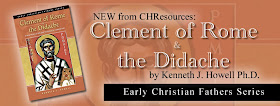Frequent commentator Chrysostom will be contributing a monthly column to this blog. Here is his inaugural post:
"Full of Grace": A Popular Exegetical and Theological InquiryA controverted rendering, and a lynchpin of Roman Catholic Mariology. As was recently written by Michael Brendan Dougherty over at
The American Conservative, the RSV-CE - Revised Standard Version, Catholic Edition - is "the mainstream option for believing Catholics", which, in the next clause, he scathingly criticizes as "descended from the King James, but [with] a few Romish flourishes like 'Hail Mary, full of grace' in Luke."
Why is this phrase - one word in the Greek - so important to Catholics, and, it would seem, to Protestants as well? (Ne'er has a Protestant Bible been seen by these shores, that containeth within it the words "full of grace" in According to Luke, Chapter 1, Verse 28.) Why is this the one "Romish flourish" that is nearly mandatory in any Bible that wishes to be called Catholic? Like the RSV-CE, all prophecy can be translated right out of the Old Testament, and typology eliminated through conjectural emendation: but, when the magic words, "hail, full of grace" are added in the right place, it becomes a Catholic version. This one word, κεχαριτωμένη (kecharitomenê) - a Biblical hapax legomenon, or word occurring only once in a given corpus, so that various uses can not be compared to draw out the likely meaning - exists in all manuscript traditions of the Greek NT: it is given the highest rating of certainty in the Nestle-Aland 27th edition. Whether using the Textus Receptus, the Nestle-Aland text, Westcott-Hort, Tischendorf, or the Byzantine Patriarchal text, the same word is translated: it is the translation itself that is in question. Next to the "עלמה-παρθένος [almah-parthenos] controversy" at Isaiah 7:14 (where the controversy is, perhaps, as much about which word to translate as how to translate a word) is possibly the most commonly- and popularly-debated translation choice in Scripture.
In many textual and translational debates, the lines are drawn between liberals, whether Protestant or Catholic, and conservatives and traditionalists, whether Protestant or Catholic: this is the case, in, say, Isaiah 7:14, in Genesis 1:1-2, in Psalm 22/23, so on and so forth - in virtually every passage that teaches or defends a traditional Christian claim or is purported to prophesy Christ - as is it in the vast majority of debates of the correct manuscript tradition (although, in the latter case, the Trads may come out swinging on the side of the Vulgate, and sidestep the critical text-textus receptus axis completely), or between high church and low church, as in the translation of ἐπίσκοπος as "bishop" or "overseer". At least in this last case, each side can attempt to muster an historical argument for their translation: in translating κεχαριτωμένη, there is no such luxury, only ideas duking it out in timeless manner.
This - the elusive translation of the elusive word κεχαριτωμένη - is a debate where the lines are drawn between conservatives and conservatives: conservative "Bible-believing" Protestants who want no Papism in their book, and conservative Catholics who want tradition and the testimony of the Fathers to bear out: the translation of the passage has incredible implications for the defense or lack thereof of Catholic Mariology by those who don't read the Greek - and the passage itself has incredible implications for the same by those who do read Greek but debate the word's meaning.
Thus I propose that the meaning of the hapax legomenon κεχαριτωμένη can not be puzzled out with certainty, or even likelihood, by purely exegetical considerations, nor even with the addition of naturalistic "historical" considerations, but only by the addition of theological considerations. The Annunciation is not amenable to modern "scientific history" even in theory, as, again, in theory, the structure of the early Church is. Even if it were, there is no recording of it outside of the Gospel of Luke: this is what we have, and on this signal word we must stand, etc. etc.














